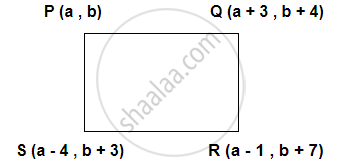Advertisements
Advertisements
प्रश्न
Prove that the points (a, b), (a + 3, b + 4), (a − 1, b + 7) and (a − 4, b + 3) are the vertices of a parallelogram.
उत्तर

PQ = `sqrt (("a" + 3 - "a")^2 + ("b" + 4 - "b")^2) = sqrt (9 + 16) = 5` units
QR = `sqrt (("a" + 3 - "a" + 1)^2 + ("b" - 4 - "b" - 7)^2) = sqrt (16 + 9) = 5` units
RS = `sqrt (("a" -1 - "a" + 4)^2 + ("b" + 7 - "b" - 3)^2) = sqrt (9 + 16) = 5` units
SP = `sqrt (("a" - 4 - "a")^2 + ("b" + 3 - "b")^2) = sqrt (16 + 9) = 5` units
Since the opposite sides of quadrilateral PQRS are equal, therefore it is a parallelogram.
APPEARS IN
संबंधित प्रश्न
In a classroom, 4 friends are seated at the points A, B, C and D as shown in the following figure. Champa and Chameli walk into the class and after observing for a few minutes, Champa asks Chameli, “Don’t you think ABCD is a square?” Chameli disagrees.
Using distance formula, find which of them is correct.

If the distance between the points (4, k) and (1, 0) is 5, then what can be the possible values of k?
Find the distance between the following pair of points:
(-6, 7) and (-1, -5)
Determine whether the points are collinear.
A(1, −3), B(2, −5), C(−4, 7)
Find the distance between the following pair of point in the coordinate plane.
(1 , 3) and (3 , 9)
Find the value of a if the distance between the points (5 , a) and (1 , 5) is 5 units .
If the length of the segment joining point L(x, 7) and point M(1, 15) is 10 cm, then the value of x is ______
Using distance formula decide whether the points (4, 3), (5, 1), and (1, 9) are collinear or not.
The point which divides the lines segment joining the points (7, -6) and (3, 4) in ratio 1 : 2 internally lies in the ______.
The point P(–2, 4) lies on a circle of radius 6 and centre C(3, 5).
